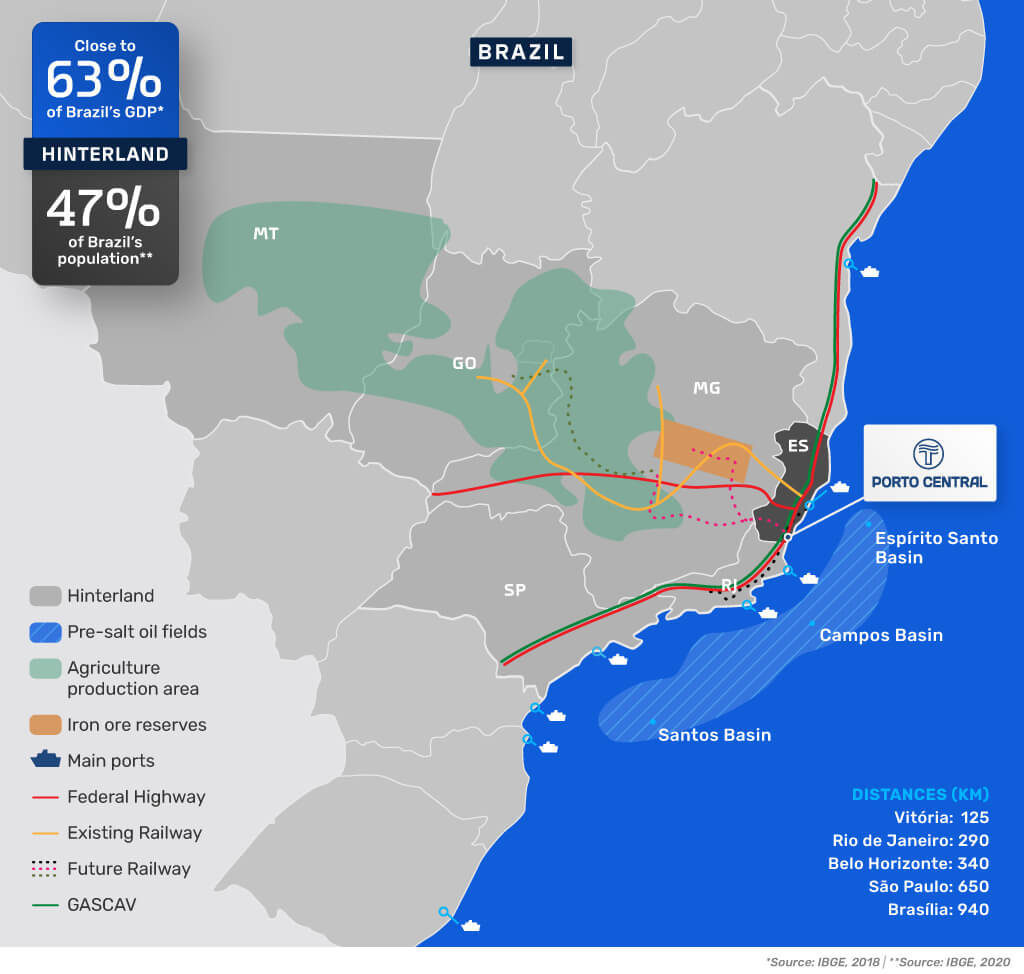The Port
- Home
- The Port
The Port
Porto Central is a private multipurpose industrial port complex, developed by the Company with the corporate name “Porto Central Complexo Industrial Portuário S.A.”, controlled by TPK Logística S.A.
TPK Logística S.A. is controlled by the Polimix Organization, active in the areas of concrete, aggregates and cement, which also consolidates a group of companies adding to its portfolio other businesses such as bulk transportation, mortar, industrial lime and renewable energy.
The infrastructure of the port complex aims to serve terminals and industries from the most diverse business sectors. With the cluster concept, whereby which terminals and industries with similar activities are strategically grouped to enable synergies and optimize operational efficiency, Porto Central will serve the following main clusters:
- Oil and Gas
- Liquid bulk
- Energy
- Offshore supply
- Agribusiness
- General cargo
- Containers
- Minerals
The port will be implemented in phases, according to market demands and the needs of our customers. The phased construction allows the duration of the port works to be brief and a faster availability of the port infrastructure.
Developed according to the port condominium model, Porto Central S.A. is responsible for the construction, maintenance and management of the common port infrastructure of the port (maritime, land and utilities), and Porto Central’s customers will be responsible for leasing areas for the implementation of their respective industries and terminals, developing the necessary superstructure for their operations.
This model reduces overall investment and operating costs for the different businesses operating in the port, as they will share the same port infrastructure developed by Porto Central, thus allowing customers to dedicate their resources to their main activities. It also provides customers operational synergies with the integration of port and industrial activities.
Layout
Porto Central will be installed in an onshore area of 1,707.70 hectares, including a green space of 207.63 hectares for environmental compensation within the perimeter of the port and another of 26.88 hectares preserved for use by the Nossa Senhora das Neves Church. With a total area of approximately 2,000 hectares (or 20 million square meters), the port will accommodate several large-scale terminals along its 10 km of berths and piers.
Its depth of up to 25 meters makes it able to receive the largest vessels in the world, including tankers and bulk carriers called Very Large Crude Carriers (VLCC’s) and Valemax, with up to 400,000 tons of capacity.
In addition, the maritime connection to the terminals will be carried out through a 25 km access channel, allowing two way of simultaneous traffic for medium-sized ships and one-way traffic for the largest ships.
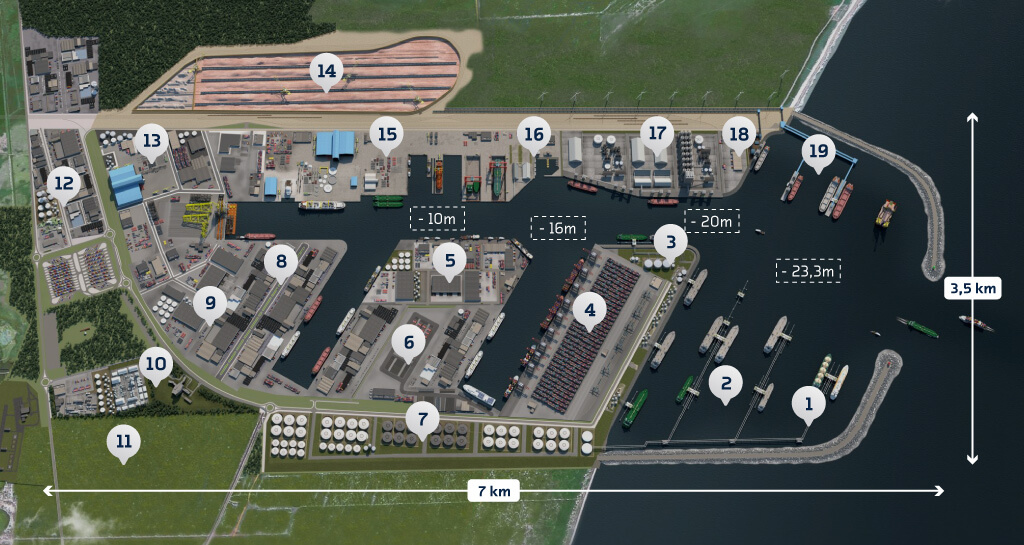 1
1
Location
Porto Central is located exactly at the center of the Brazilian coast, in the extreme South of the State of Espírito Santo in the Municipality of Presidente Kennedy. It is located about 5 km from the border between the State of Espírito Santo and Rio de Janeiro and 150 km south of the capital of Espírito Santo, Vitória.
In 2009, the area chosen for the development of Porto Central was previously identified by the National Agency for Waterway Transport (ANTAQ), in the General Plan of Authorizations for the Port Sector, as a priority and ideal for the installation of a port.
It is located within 6,815 hectares designated by the Municipality of Presidente Kennedy as an industrial district with a view to contributing to the planned and integrated growth of the region.
Porto Central will meet a high demand from businesses that need logistical alternatives in the states of Espírito Santo, Minas Gerais, Goiás, Mato Grosso, São Paulo and Rio de Janeiro, which, together, represent more than 63% of Brazil's Gross Domestic Product (GDP) and have great importance in agricultural, iron ore and industrial production.
Its central location is strategic to consolidate a true cargo distribution hub through the different logistics modes that access the port and an exit port connected to the main international routes and one of the most efficient to reach the markets of Asia and the Middle East.
The privileged position in the Southeast Region, close to the main oil and gas fields in the country, highlights Porto Central as an efficient point for the handling and storage of crude oil, natural gas and offshore supply. More than that, it is unique, in the center of the Brazilian coast, close to the major producing centers in Brazil and a market with more than 100 million consumers.
Accesses
Porto Central recognizes the fundamental need to have adequate accessibility infrastructure, as this determines a large part of the port's success and the country's competitiveness.
Thus, connecting the logistics infrastructure is a fundamental factor, and Porto Central is working intensively with municipal, state and federal institutions for the improvement and development of access to the port.
- Maritime
- Road
- Rail
-
 Pipeline
Pipeline
Porto Central, as a multipurpose port, will enable the access of the most varied types of ships, from Panamax to Valemax, through a main access channel and a set of internal channels, structured with the highest standards of safety and efficiency. To this end, Porto Central, in partnership with the University of São Paulo (TPN-USP), a renowned polytechnic school, under the supervision of pilots from Espírito Santo and the Brazilian Navy, carried out several maritime simulations in real time considering different environmental conditions of wind, waves and currents.
Local tugboat operators also participated in the simulations in order to have a complete realistic approach with regard to tugboat assistance, as well as maritime experts from the Port of Rotterdam were involved in this development. Several port layouts have been tested and optimized.
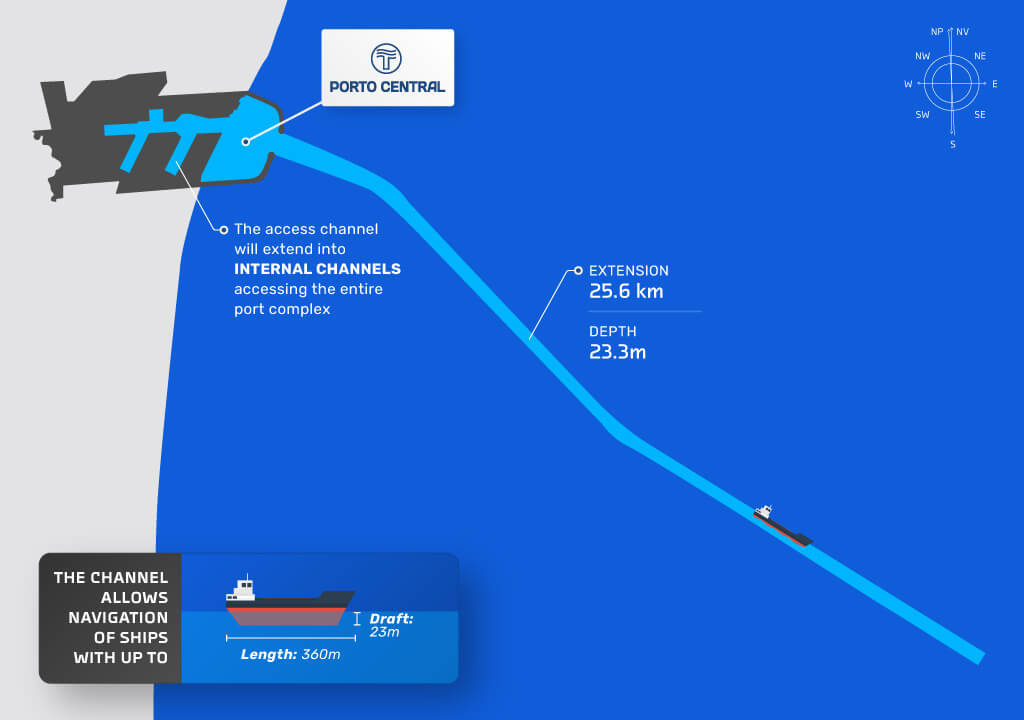
Porto Central has a wide network of accesses to the main road networks in the country. Through Espírito Santo state highways (ES-060, ES-162 and, in the future, ES-297), it connects to federal highways BR-101, providing access to the north and south of the country, and BR-262, providing access to the east and west of the country.
In accordance with the Term of Commitment for Road Adequacy, signed by the Espírito Santo State Government and the Municipality of Presidente Kennedy, logistics will become even more efficient, as improvements will be made in the three state roads that give access to the port, so that they are completed by the start of port operations.
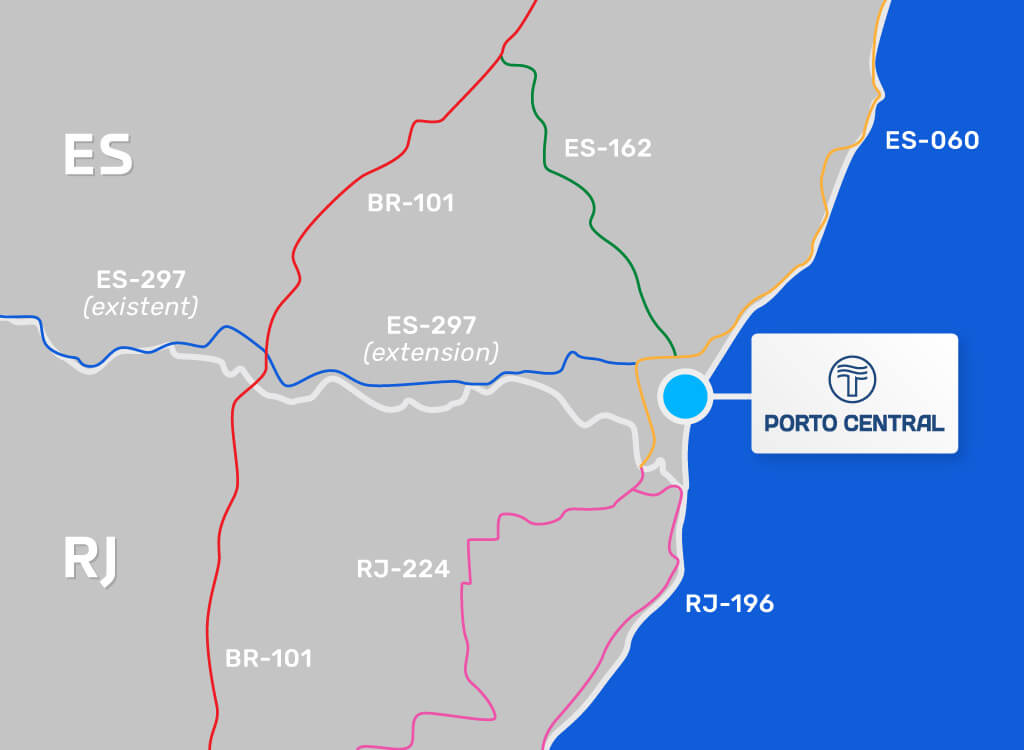
There are two major railway projects planned by the Federal Government that will provide rail access to the port complex facilities: EF-118 and EF-352.
The new EF-118 railway, with 572 kilometers in length, is part of the Federal Government's Infrastructure and Logistics Program and will connect the capital of Espírito Santo, Vitória, to the capital of Rio de Janeiro, Rio de Janeiro. This railway will be linked to existing systems:
To the north, with the Vitória-Minas Railroad (Vale), on the stretch that connects the capital Belo Horizonte (MG) to the capital Vitória (ES), and the Central Atlantic Railroad (FCA), from the State of Goiás to Minas Gerais;
To the south, with the Company MRS Logística, and several port terminals on the coast of Espírito Santo and Rio de Janeiro, including the ports of Tubarão and Vitória, Ubu, Açu and Rio de Janeiro, in addition to Porto Central.
The EF-118 route will arrive in front of the main gate of Porto Central, connecting the railway branches inside the complex and reaching most terminals and industries.
Macro Development, a developer of business solutions focused on promoting industrial, energy, logistics and real estate projects, was authorized in December 2021 by the Ministry of Infrastructure to develop the future EF-352 railroad, which will interconnect the Municipalities of Presidente Kennedy (ES), Conceição de Mato Dentro and Sete Lagoas (MG) and Anápolis (GO).
The extension of the first stretch of the railroad from Presidente Kennedy (ES) to Conceição de Mato Dentro (MG) and the region of Sete Lagoas (MG) will be of 610 km. The second stretch from Sete Lagoas (MG) to Anápolis (GO) it will be 716 km.
The new railway will provide a direct connection from Porto Central to the Midwest Region of the country, crossing important mineral and agricultural regions of the country, as well as being connected to the EF-118 railway.
Future railroads will offer a new economic and competitive logistical alternative for the export and import of cargo, even over long distances, such as liquid bulk, iron ore, grains, fertilizers, general cargo, containers and other commodities.
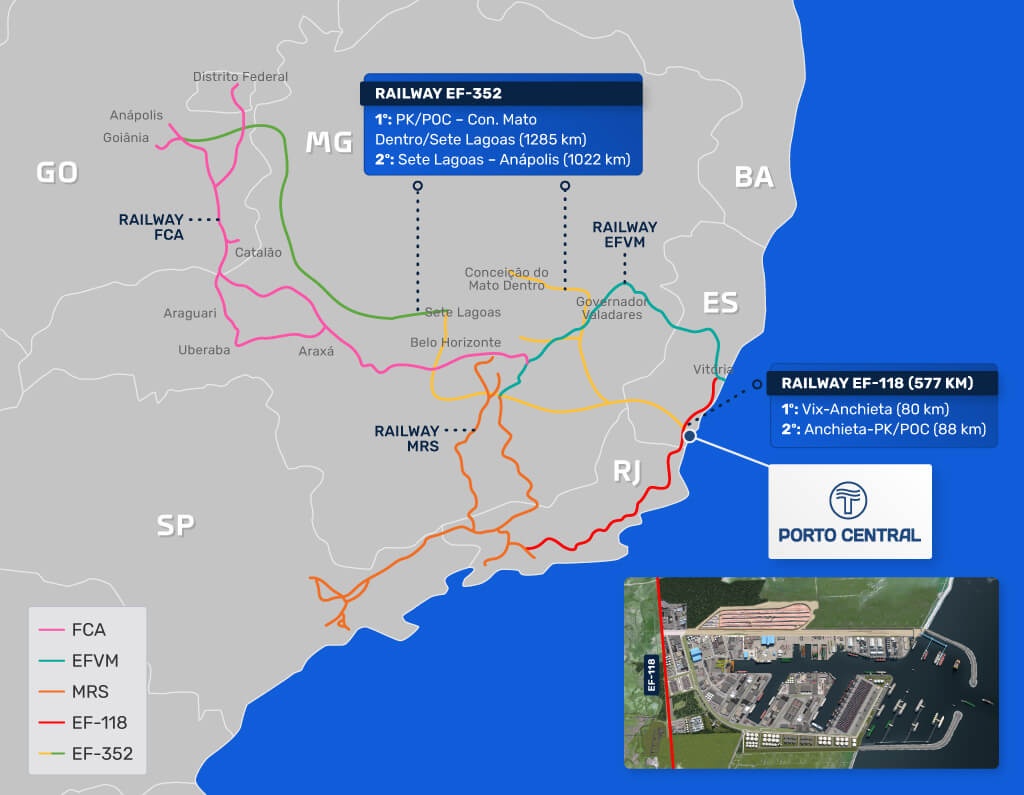
In addition to the development of maritime, rail and road access, Porto Central is also coordinating a pipeline network to offer yet another safe, efficient and sustainable cargo transport solution.
A space was reserved within the complex to ensure a protected location for the installation of product pipelines for liquid bulk cargoes and natural gas, as well as utility pipeline corridors.
Porto Central will serve as an important center for receiving and distributing natural gas for the region and the hinterland of the port and can be easily connected to the existing gas pipeline network of the Southeast-Northeast National Network, GASCAV/GASENE, which connects the Cabiúnas Terminal in Macaé (RJ) to the Serra Intermodal Terminal Station in Vitória (ES), with a total length of 303 km. The western limit of the port is just 10 km away from this grid.
One of Porto Central's competitive advantages is also its strategic location, close to offshore oil and natural gas production fields. For this, a new maritime gas pipeline can be developed for the flow of this associated gas to be treated and commercialized through the infrastructure available at Porto Central.
It is worth mentioning that technical studies by the Energy Research Company - EPE of the Ministry of Mines and Energy have already indicated Porto Central as one of the possible locations to receive a new gas offshore route (called Route 6), as well as a new gas pipeline with an extension of 332 km, starting from the interconnection at GASCAV – Porto Central, going to the GASBEL pipeline in Minas Gerais.
This modal will facilitate the transport, supply and dispatch of liquid bulk, such as crude oil, derivatives, bunker (marine fuel), green fuels, as well as the commercialization of more competitive imported and national gas for local consumers, especially located in Espírito Santo. and Minas Gerais, which are states that concentrate large industries (steel production, cement, plants, cellulose plants, food processing, thermoelectric plants, among others).


